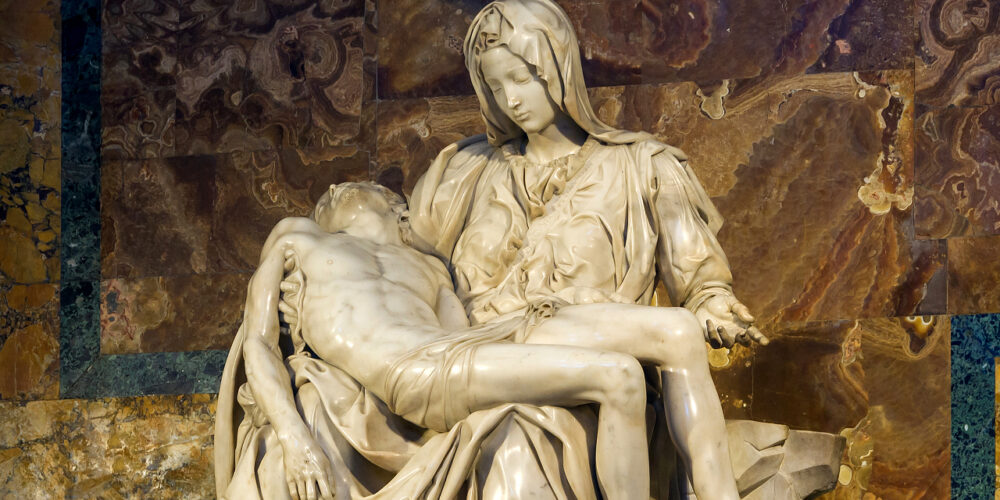Mary Ann Sures (1928–2020) was an art historian who lectured extensively, beginning in the early 1960s, on the application of Objectivist esthetics to the visual arts. She did graduate work in art history at the Institute of Fine Arts of New York University and at Hunter College, from which she received an MA. She taught art history at New York University (Washington Square College) and at Hunter College. She was coauthor with her husband, Charles, of Facets of Ayn Rand, a memoir of their longtime friendship with Ayn Rand and her husband, Frank O’Connor.
“Metaphysics in Marble” was originally published in Ayn Rand’s magazine The Objectivist (February and March 1969) and is recommended by Rand in The Romantic Manifesto. The original article contained no footnotes or images, relying instead on vivid descriptions of the sculptures discussed. The editors are pleased to publish it here in New Ideal with the author’s added footnotes. (In a few instances, written text accompanies these linked images; neither the editors nor the author endorses these texts, and they are not part of the article. In cases where links selected by the author have ceased functioning, the editors have inserted new links to images resembling the originals as closely as possible.)
Start with Part 1 here
Metaphysics in Marble
By Mary Ann Sures
Part II
For the classical Greek world, its statues of gods and athletes were models of perfection and a source of inspiration. For the medieval world, its pathetic, huddled images of man were constant reminders of depravity and a source of shame and humiliation.
There was no place in the medieval culture for a statue that glorified man; and so, after the collapse of ancient civilization, the classical statues were abandoned to the hostile barbarism of the populace. The early Christian church fathers are said to have considered them dangerous, believing them to be inhabited by devils. Large numbers of these statues were destroyed. Some were hidden in private collections. The rest were forgotten and gradually buried under the rubble of centuries—just as the human spirit they embodied was buried by medieval mysticism. Both the statues and the spirit remained buried until the Renaissance.
The Renaissance of the fifteenth and sixteenth centuries was a conscious rebellion against the anti-human, otherworldly values of medieval Christendom. In its metaphysics and epistemology, the Renaissance was essentially Aristotelian. Every aspect of the period, from science to literature to art, reflected the Aristotelian view that man is a worthy being, capable of understanding the universe, and that the universe is worthy of man’s interest and study. Mysticism, which had saturated every aspect of medieval life and culture, lost its stranglehold on man’s mind. A rebirth of reason and of concern with this earth, was the base of all the achievements of the Renaissance.
In terms of its morality, the Renaissance was split in two: it was part-Aristotelian, part-Christian. As Aristotelians, the men of the Renaissance displayed the virtues of intelligence and pride, and pursued the value of happiness on earth. As Christians, they upheld the virtues of humility, renunciation and self-sacrifice, and the value of rewards in Heaven. Thus the existentially brilliant era of the Renaissance was marred, spiritually, by a profound moral conflict.
That conflict appeared, in different degrees, in virtually all of the Renaissance art. For the most part, sculpture did reflect an affirmative view of man. Although the subject matter was largely Christian, sculptors abandoned the stylistic features of medieval art. They restored weight, three-dimensionality and natural proportions to the human body. They reintroduced free-standing figures. They were keenly aware of human anatomy, and created images of potentially active bodies, or of bodies engaged in energetic movement. And, equally significant, the naked body was featured in the representation of both Christian and pagan subjects.
The statues present men who have intelligence, courage, determination and strength of character; but they do not convey a sense of happiness. The moral conflict tinged the Renaissance view of life, and in the faces of the statues there is a touch of sadness or uncertainty or tragedy, an expression of longing for an ideal never fully reached.
The statue of St. George by Donatello is a youthful knight in armor, facing existence with an upright posture and a firm stance, exhibiting competence and energy. The face, however, is troubled; the wrinkled brow suggests both concentration and uncertainty.1
Turning for a moment to painting: Botticelli’s Birth of Venus features a graceful, naked goddess whose delicate face reveals a serene spirit, but it is serenity mixed with melancholy and wistfulness.2
Michelangelo was the greatest artist of the Renaissance, and his work may be taken as representative of the spirit of that era. The same conflict appears in his sculpture, but with an intensity unequaled in the work of others. When he began, as a young man, his statues conveyed near-triumph. Then, the triumph gave way to struggle and tragic heroism, then to frustration, and, at the end, to despair and futility.
In his first version of the Pietà, Michelangelo eliminated the emphasis on physical torture and spiritual agony. The Virgin has the strength to support the body lying across her lap; her hand is held out in a gesture of quiet resignation; her head is bowed in solemnity. There are no tears on her face; she expresses sorrow, not suffering. Christ’s body and face are relaxed and smooth; the wound in his chest is unstressed and clean. Michelangelo portrayed the subject in a manner that ennobled both figures: they are not broken by physical or spiritual pain, but transcend it. Compare the style and spirit of this work to the medieval example of the same subject, discussed earlier.3
Michelangelo’s David is one of his most eloquent works. Earlier Renaissance versions of the subject had presented David after his triumph, standing with sword in hand and with the head of Goliath at his feet. Michelangelo chose to present David in the moment before he hurled the stone—to portray a youth who has to and will be triumphant. He stands with his head held high, his slender, strong body prepared for the encounter. The side of the figure facing the enemy, is posed in insolent defiance; the leg is relaxed, the arm is raised to hold the sling in readiness. The other side of the figure is tense; the straight leg supports the weight of the body, while the fingers of the powerful hand curl around the stone. The statue conveys the victory of the mind over brute, physical force. It portrays man as fearless, intelligent and triumphant, but man with a troubled brow, looking out with a touch of apprehension.4
By the time Michelangelo carved the Dying Slave, about ten years later, the near-triumph of the David had given way to tragic heroism. The figure is shown at the moment when he has ceased struggling against the fetters binding his chest, when—with one knee bent—his youthful body gives in to exhaustion and begins to collapse. One arm presses tightly against his torso, but its hand rests limply on his chest, its energy gone. The statue conveys the futility of man’s struggle. It portrays man as a being for whom existence means struggle and who will respond to the challenge, but who will struggle in vain.5
In one of Michelangelo’s last works, another version of the Pietà (which was left unfinished), Christ’s body sags helplessly at the feet of a figure who is unable to support him. The Christian elements in Michelangelo’s soul had won.6
Whether intensified, as in the work of Michelangelo, or subtly implied, as in the work of some of his contemporaries, such was the conflict torturing and undercutting the spirit of the Renaissance.
From the seventeenth to the mid-nineteenth century, the growing currents of a profound retrogression engulfed the realm of philosophy. It was a gradual movement from an Aristotelian to a Platonic base—from the conviction that reality is intelligible and reason is man’s means of perceiving it, to the belief that reality is unknowable, and reason, at best, is limited. The climax and victory of that trend were represented by the philosophy of Immanuel Kant, in the late eighteenth century. After Kant, as Platonism’s influence gained momentum, man’s stature, in the eyes of philosophers, sank rapidly, undercut by the currents of mysticism and skepticism.
But the influence of philosophy does not penetrate and change every human activity at once; sculpture remained comparatively untouched during this period. From the Renaissance to the mid-nineteenth century, sculpture continued to reflect a positive view of man; the Greek classical tradition remained a strong influence. There were stretches of time when sculpture became predominantly imitative and superficial, especially in the first half of the nineteenth century. But, for about two hundred and fifty years, man’s body was presented in a natural manner, and his spirit was neither glorified nor degraded.
By the second half of the nineteenth century, the philosophical views of generations of intellectuals had emerged from the theoretical realm and permeated the general culture. Holding that existence is unknowable, abandoning the quest for certainty and for moral values, philosophy shattered man’s self-confidence. It fashioned a view of man which raised a mixture of disillusionment, doubt and hopelessness to the status of man’s essence. That view was given visual expression in the work of Auguste Rodin.
As a characteristic of his work, Rodin introduced an element that had been rare in sculpture since the end of the Middle Ages: human ugliness. His figures combine ugliness with extreme physical discomfort, expressing his subjects’ state of mind. His figures are presented in bent, twisted, strained, squatting and huddled positions; musculature is distorted; faces are left unfinished. The surfaces of the material, usually bronze, are highly polished, but beneath the sheen one can distinguish uneven ridges and hollows that make the skin texture look broken and unhealthy.
She Who Was Once the Helmet-Maker’s Beautiful Wife is the seated figure of an old, naked woman, with gnarled limbs, sagging skin and shrunken breasts. Her sharp, thin shoulder blades protrude from her wasted back; one arm is drawn behind her, with the hand open, palm out, fingers outstretched, as if she is repelled by her hideous appearance and cannot bring herself to touch her own body.7
Another statue, Eve, stands wrapping her arms around her chest, hiding her breasts in anguish and shame.8
One of Rodin’s most famous and popular works, The Thinker, sums up his view of man’s wretched state.9 The figure is seated, hunched over in a position that combines strain and limpness. The muscles in his arms, legs and toes are knotted and cramped. The size and development of his body indicate that it was once powerful and energetic, but is now exhausted. His external, physical state reveals his inner strain: the strain of engaging in mental activity.
Rodin’s despondent figures were only a hint, a mild foretaste, of what was to come in the generations that followed—when both philosophy and sculpture collapsed under the weight of twentieth-century irrationalism.
The contemporary view of man’s nature is summarized in the following observation: “We have been made aware of how small a part of the human being is represented by the reason, which could be likened to that part of the iceberg which is visible, the mere cap of a submerged mass, deep and dense, which is the human psyche, whose profound levels are not to be measured quantitatively by the scientific method.” (Samuel M. Green, “The Unthinks: The Distrust of Reason as Seen in the Contemporary Arts,” Wesleyan University Alumni-Faculty Seminar, June 1959, p. 21.) Man, according to contemporary philosophy, is fundamentally irrational; his reason is not merely limited, it is a barrier to the expression of his “true” nature.
The neo-mystics of philosophy have discarded, as a useless endeavor, the study of epistemology and ethics; and, while one school bickers over the meaning of words, another tells man that life can have no meaning. What is the nature of reality? Reality—according to a prevalent answer—is an indeterminate flux, a flow of contradictions and ambiguities. Can man acquire knowledge of the world? Knowledge, they all answer, is impossible to man; faced with an unintelligible world, his reason is useless; all he can do is snatch a few disconnected experiences from the flux. How is man to guide the course of his life? Man, they answer, cannot guide his life; he cannot define values or set goals. Consequently, say the psychologists, man is run by a multitude of powers outside his control and beyond his comprehension—by his genes, by social forces, by inexplicable feelings, whims and urges (the “profound levels” of the “human psyche”). Man, they declare, must live from day to day, from urge to urge; there are no principles or standards to guide his conduct. As a starting point, the existentialists say, man must accept the fact that life is anguish and that his appropriate and constant response to being alive is nausea.
Man as an irrational creature who lives in a perpetual state of anxiety and terror, is the theme of the sculpture offered today.
Man’s desire to see the objectified reality of his basic self-estimate can lead him to search for the art of cultures other than his own, as the men of the Renaissance searched for the art of ancient Greece and Rome. Observe an eloquent symptom of the spiritual state of today’s culture: the popularity of the primitive art of the jungle.
For example, consider the following excerpt from a press release announcing an exhibition held in New York City in 1958, at the Museum of Primitive Art. The exhibition was entitled “African Sculpture Lent by New York Collectors.” The release explains that the sculpture was: “Drawn from the collections of people in a wide variety of professions, including businessmen, museum directors, a sculptor, a photographer, a composer and a psychiatrist . . . The objects range from bronze portrait heads and stylized wooden human figures through fantastic masks used in secret society rites and fetish figures decorated with mirrors, nails and feathers. Both human and animal forms are used and occasionally the two are even combined.”
“. . . the Museum’s founder and president thanked the lenders to the exhibition and . . . [said] ‘that there has been a great increase in the public’s awareness and interest in primitive art.’”
This museum’s founder and president is Nelson A. Rockefeller.
The following are examples of what the public is aware of and interested in:
From the Congo, the statue of a woman.10 The size of her head is one-third the length of her body; human proportions have been totally destroyed. The torso, which consists of a protruding stomach and huge breasts that originate where one would expect a collarbone, rests on two curved hunks of wood that serve as legs. There being no joints or muscles in the legs, and virtually no thighs, the capacity for movement is non-existent. A head with pursed lips and gashes for eyes completes the figure.
From Easter Island, a male figure.11 Elongated and emaciated, the length of his torso is twice the length of his scrawny legs and thighs. Enormous staring eyes, a grimacing mouth and slumped shoulders complete the figure.
From the prow of a Polynesian canoe, a small, stiff, muscleless figure, sex indeterminate.12 With its arms pressed to its stomach and its face wearing an expression of mild bewilderment, it served to placate the many gods with which the Polynesians had populated their universe; it was there to plead that the canoe might pass, unharmed. If one compares this figure to the Winged Victory of Samothrace, one grasps the power of sculpture to express man’s soul by means of shaping his body.13
The alternative to primitive sculpture, in today’s art circles, is the work of the contemporary “anxiety school,” which turns out mutilated images of man. Contemporary philosophy, constantly chipping away at the “mere cap” of reason, seeks to destroy man’s confidence in the power of his mind. Members of the “anxiety school” of sculpture move in and, like buzzards, finish off his body.
Man’s body, in this type of sculpture, is stretched out, flattened, punctured, disfigured, dismembered. He is shown without a head—or with arms that have no hands, or with hands that have no fingers—or with a face that has no mouth, and a head that has no face.
He is a tall, skinny, stick-like figure with a tiny head, with club feet, and with flesh and skin like dripping lumps of rot (by Alberto Giacometti).14
He is an inflated bug on its side, with a knob for a head, with a swollen belly, and limbs like stumps of charred wood projecting from the misshapen mass (by Kenneth Armitage).15
He is a bloated thing infected all over with elephantiasis, metamorphosing into a gigantic pretzel (by Henry Moore—those that are recognizable).16
He is a mummy bound in corroded metal strips, with spikes stuck into what is left of his body (by Leslie Thornton).17
He is an unfinished marionette, without anatomical details (by Marino Marini).18
These are the creatures offered to man as visual embodiments of his metaphysical nature. They are the inhabitants of a world made by Heraclitus, Plato, Kant, Hegel, James, Sartre and Wittgenstein, a world in which man can know nothing, desire nothing, achieve nothing.
Philosophy is the sculptor of man’s soul. And sculpture is philosophy in stone.
Do you have a comment or question?
Endnotes
- Donatello. St. George. 1415–1417. Museo Nazionale del Bargello, Florence. Note: This image can be enlarged by clicking on it.
- Botticelli. The Birth of Venus. c. 1482. Uffizi Gallery, Florence. Note: This image can be enlarged by clicking on it. See also detail of head, The Birth of Venus.
- Michelangelo. Pietà. 1498/99–1500. St. Peter’s, Vatican.
- Michelangelo. David. 1501–1504. Academy, Florence. Note: This image can be enlarged by clicking on it. See also detail of head, David.
- Michelangelo. Dying Slave. 1513–1516. Louvre, Paris. Note: This image can be enlarged by clicking on it. See also detail of head and torso, Dying Slave. Note: This image can be enlarged by clicking on it.
- Michelangelo. Rondanini Pietà. 1564. Sforza Castle, Milan. Note: This image can be enlarged by clicking on it.
- Auguste Rodin.She Who Was Once the Helmet Maker’s Beautiful Wife, also called The Courtesan. Modeled 1887, this bronze cast 1910. Metropolitan Museum of Art, New York. Note: This image can be enlarged by clicking on it.
- Auguste Rodin. Eve. Modeled 1881, this bronze cast 1911. Rodin Museum, Paris.
- Auguste Rodin. The Thinker. Modeled 1880, this bronze cast 1903. Rodin Museum, Paris. Note: This image can be enlarged by clicking on it.
- Standing Female Figure. Late 19th century. Democratic Republic of the Congo. Brooklyn Museum. Note: The figure described in the article is not available on the Internet; however, this figure is similar in many respects.
- Male Figure. Early 19th century. Easter Island. Metropolitan Museum of Art, New York. Note: The figure described in the article is not available on the Internet; however, this figure is similar in many respects.
- The figure described in the article is not available on the Internet. However, it is similar to the male figure referenced in footnote 22 above.
- Winged Victory of Samothrace. c. 190 B.C. Louvre, Paris.
- Alberto Giacometti. Falling Man. 1950. Musée Calvet, Avignon.
- Kenneth Armitage. Figure Lying on Its Side (Version V). 1957. British Council of the Arts.
- Henry Moore. Reclining Figure. 1939. Detroit Institute of Arts.
- Leslie Thornton. Crucifix. 1958. Private collection. Note: The referenced image is fifth from the top of the page.
- Marino Marini, Horseman. 1947. Tate Gallery, London.








